Warmingup、Pre-reading、Reading、Comprehending (2)
- 格式:ppt
- 大小:7.18 MB
- 文档页数:72
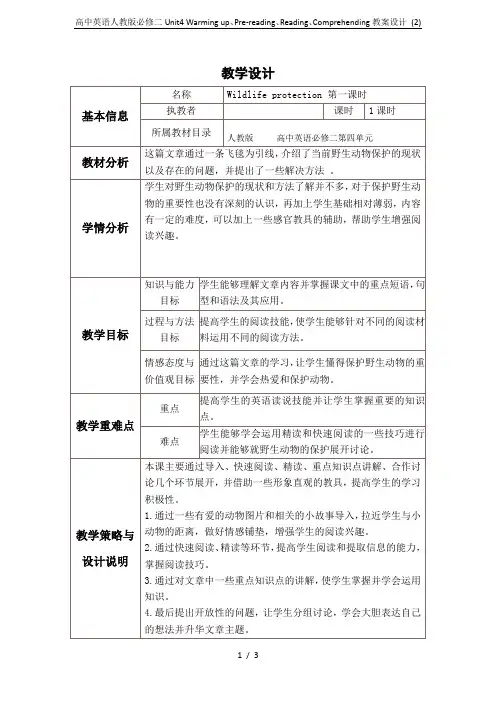
基本信息
名称Wildlife protection 第一课时
执教者课时1课时所属教材目录
人教版高中英语必修二第四单元
教材分析这篇文章通过一条飞毯为引线,介绍了当前野生动物保护的现状以及存在的问题,并提出了一些解决方法。
学情分析学生对野生动物保护的现状和方法了解并不多,对于保护野生动物的重要性也没有深刻的认识,再加上学生基础相对薄弱,内容有一定的难度,可以加上一些感官教具的辅助,帮助学生增强阅读兴趣。
教学目标知识与能力
目标
学生能够理解文章内容并掌握课文中的重点短语,句
型和语法及其应用。
过程与方法
目标
提高学生的阅读技能,使学生能够针对不同的阅读材
料运用不同的阅读方法。
情感态度与
价值观目标
通过这篇文章的学习,让学生懂得保护野生动物的重
要性,并学会热爱和保护动物。
教学重难点重点
提高学生的英语读说技能并让学生掌握重要的知识
点。
难点
学生能够学会运用精读和快速阅读的一些技巧进行
阅读并能够就野生动物的保护展开讨论。
教学策略与设计说明本课主要通过导入、快速阅读、精读、重点知识点讲解、合作讨论几个环节展开,并借助一些形象直观的教具,提高学生的学习积极性。
1.通过一些有爱的动物图片和相关的小故事导入,拉近学生与小动物的距离,做好情感铺垫,增强学生的阅读兴趣。
2.通过快速阅读、精读等环节,提高学生阅读和提取信息的能力,掌握阅读技巧。
3.通过对文章中一些重点知识点的讲解,使学生掌握并学会运用知识。
4.最后提出开放性的问题,让学生分组讨论,学会大胆表达自己的想法并升华文章主题。
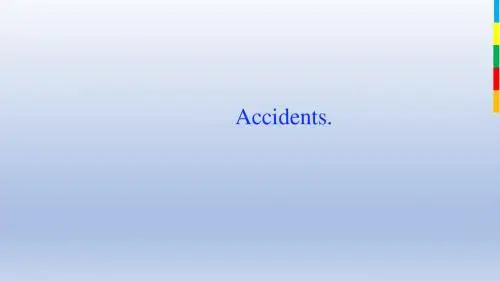
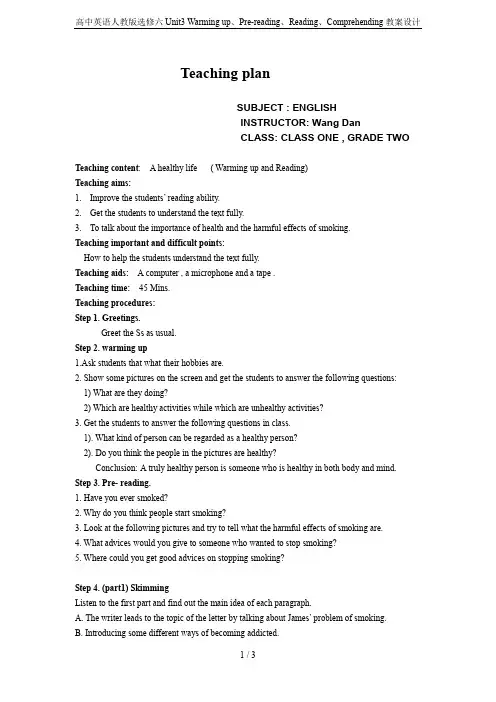
Teaching planSUBJECT : ENGLISHINSTRUCTOR: Wang DanCLASS: CLASS ONE , GRADE TWOTeaching content: A healthy life ( Warming up and Reading)Teaching aims:1.Improve the students’ reading ability.2.Get the students to understand the text fully.3.To talk about the importance of health and the harmful effects of smoking.Teaching important and difficult points:How to help the students understand the text fully.Teaching aids: A computer , a microphone and a tape .Teaching time:45 Mins.Teaching procedures:Step 1. Greetings.Greet the Ss as usual.Step 2. warming up1.Ask students that what their hobbies are.2. Show some pictures on the screen and get the students to answer the following questions:1) What are they doing?2) Which are healthy activities while which are unhealthy activities?3. Get the students to answer the following questions in class.1). What kind of person can be regarded as a healthy person?2). Do you think the people in the pictures are healthy?Conclusion:A truly healthy person is someone who is healthy in both body and mind. Step 3. Pre- reading.1. Have you ever smoked?2. Why do you think people start smoking?3. Look at the following pictures and try to tell what the harmful effects of smoking are.4. What advices would you give to someone who wanted to stop smoking?5. Where could you get good advices on stopping smoking?Step 4. (part1) SkimmingListen to the first part and find out the main idea of each paragraph.A. The writer leads to the topic of the letter by talking about James’ problem of smoking.B. Introducing some different ways of becoming addicted.C. Telling the writer’s hope for his grandson and a dvice on stopping smoking.D. Telling the harmful effects of smoking.E. From the life the writer is leading now, we can know the importance of healthy life.Keys: para.1-----E para.2-----A para.3----B para.4-----D para.5-----CStep 5. (part1) Detail readingStep 6. (part2) skimming1. Listen to the second part and find out t he suggestions James’ grandfather found on the Internet. Suggested answers:1)Prepare yourself.2)Be determined.3)Break the habit.4)Relax.5)Get help if you need it.6)Keep trying.Step 7. (part 2) detail reading.Listen to the second part of the passage and fill in the blanks in the following summary.Choose a day that is not _______ to quit smoking. Make a list of all the _______ you will get from stopping smoking. __________ all your cigarettes. ______ the list of benefits when you feel like smoking. Develop some other habits to keep yourself ____. If you feel nervous or stressed, try some ________ exercises like deep breathing. You can stop smoking with a _____ or join a group. If necessary, ask a doctor or ______ for help. The most important is to keep _____. Don’t feel _______ if you have a cigarette again. Just ___ again.Check the students’ answers.Suggested answers:Stressful, benefits, throw away , Reread , busy ,Relaxation , friend, chemist , trying ,ashamed , try.Step 8. Discussiondrugs alcohol HIV/AIDS exercise stress smoking sleeping habits dietDiscuss with your partner and decide on a health issue concerns you most.1. How does this issue affect your health?2. How could it affect your school life?3. Give a few suggestions.Step 9.Summary1. Reading Skills: Skimming & Scanning2. About the topic “A Healthy Life”:The description of a healthy personHealthy and unhealthy activitiesThe harmful effects of smokingSuggestions given to smokers to quit smoking3.Hold a discussionStep 9. some proverbs on health1. An apple a day keeps the doctor away.2. Early to bed and early to rise, makes a man healthy, wealthy and wise.3. A light heart lives long.4. Good health is over wealth.5. Health is happiness.Step 10. Homework1. Discuss the questions after class.2. Finish Ex 1& 2, page 20.3. Search some more information about the harmful effects of smoking and advice on stoppingsmoking.Step 11. Ending。
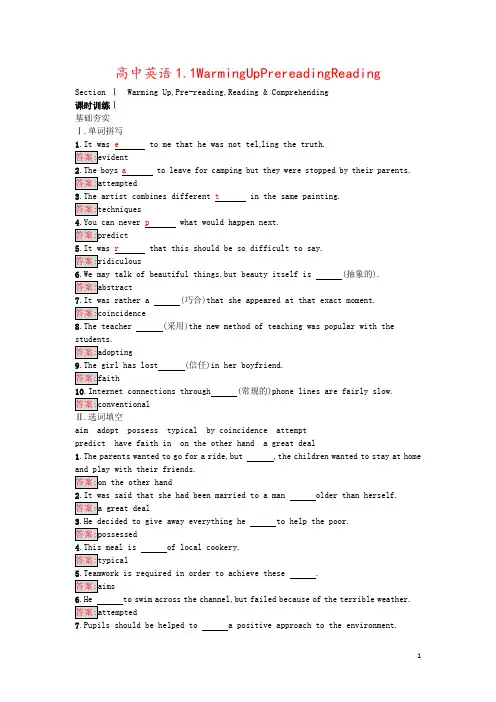
高中英语1.1WarmingUpPrereadingReadingSection ⅠWarming Up,Pre-reading,Reading & Comprehending课时训练Ⅰ基础夯实Ⅰ.单词拼写1.It was e to me that he was not tel ling the truth.答案:evident2.The boys a to leave for camping but they were stopped by their parents. 答案:attempted3.The artist combines different t in the same painting.答案:techniques4.You can never p what would happen next.答案:predict5.It was r that this should be so difficult to say.答案:ridiculous6.We may talk of beautiful things,but beauty itself is (抽象的).答案:abstract7.It was rather a (巧合)that she appeared at that exact moment.答案:coincidence8.The teacher (采用)the new method of teaching was popular with the students.答案:adopting9.The girl has lost(信任)in her boyfriend.答案:faith10.Internet connections through(常规的)phone lines are fairly slow.答案:conventionalⅡ.选词填空aim adopt possess typical by coincidence attemptpredict have faith in on the other hand a great deal1.The parents wanted to go for a ride,but ,the children wanted to stay at home and play with their friends.答案:on the other hand2.It was said that she had been married to a man older than herself.答案:a great deal3.He decided to give away everything he to help the poor.答案:possessed4.This meal is of local cookery.答案:typical5.Teamwork is required in order to achieve these .答案:aims6.He to swim across the channel,but failed because of the terrible weather. 答案:attempted7.Pupils should be helped to a positive approach to the environment.答案:adopt8.No one believed her that the tsunami would arrive on December 26.答案:prediction9.,we arrived here at the same time.答案:By coincidence10. oneself is the first step to succeed.答案:Having faith inⅢ.完成句子1.The film (由……改编)the popular novel for children.答案:was adapted from2.The workers worked hard (试图完成这项任务)before July.答案:in an attempt to finish the task3.Jack was always (第一个到校的学生).答案:the first student to arrive at school4.Because of his gambling,Scott (失去了他拥有的一切). 答案:lost everything he possessed5.(我急于学会)how to ride my new bicycle once I got it.答案:I was eager to learn6.(巧合的是),Paul and Jim were traveling on the same train.答案:By coincidenceⅣ.翻译句子1.如果没有电,我们的生活会很困难。
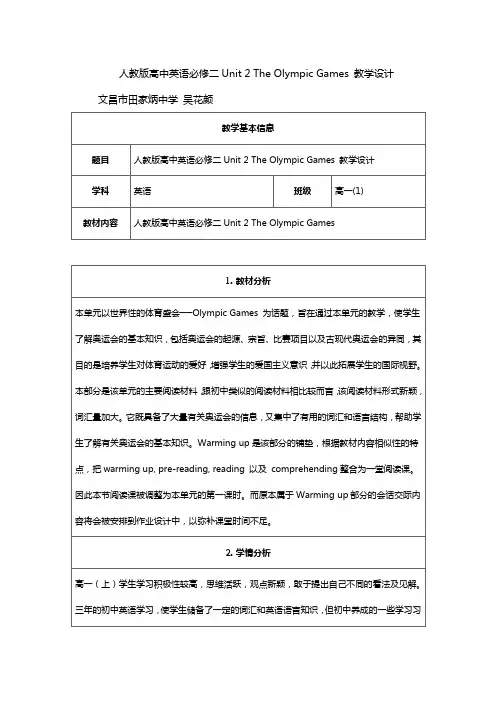
高一英语必修2第二单元Olympic Games第一课时教学反思文昌市田家炳中学吴花颜本课是高一英语必修2第二单元第一课时的内容,课型为阅读。
以下是我对本堂课的教学反思。
反思一:阅读材料的理解和阅读技巧的培养本节课课题奥运会为学生所熟悉,所以学生有话可说。
尤其是继2008北京奥运会之后。
所以学生对于本单元话题吸取较浓。
学生准备的也比较充分。
方便了教师的教学,同事对教师也提出了更多的要求。
传统的看法认为教师的任务就是传授知识, 按韩愈说的就是“传道授业解惑”, 但是仅仅传授知识是不够的。
要提高学生的素质, 就要培养学生的能力。
因此英语阅读教学中要突出“学”字, 从让学生“学会”转到培养学生“会学”, 授之以法, 把学习的主动权交给学生。
学会怎样学习, 对学生来说是至关重要的。
学生只有掌握了科学有效的学习方法。
在阅读课中,教授学生正确的阅读方法是非常重要的。
而我在这方面做得还不够。
阅读技巧的传授不是教师说一次学生就能接受掌握的,这种方法的传授要渗透在每次的阅读课的教学中,这样才能使学生形成良好的阅读习惯。
反思二:问题的设置问题设计是英语阅读教学的重要手段, 是帮助学生理解、鉴赏文章的切入点。
教师设计问题, 要遵循循序渐近的原则, 要把问题建筑在学生的注意力和兴趣之上,服务于全面提高学生素质水平的目标需要。
高中英语课文大多篇幅较长。
课文内容参透了丰富的审美以及科学教育内容。
在这些兼顾知识性、趣味性、思想性的阅读课教学中精心设计既有启发性又能激起学生探讨兴趣的系列问题, 可以启迪学生动脑, 激发学生思维,培养学生主动学习的习惯。
1以《我和你》2008北京奥运主题曲导入,大家一起唱,引起学生的兴趣,这部分做得很好。
2 Which number is concerned with the Olympic Games?FiveWhat do the five rings stand for?The five interlocking rings stand for friendship of five continents.3 talk about 2008 Beijing Olympic mascot 这部分做得很好4 the Olympic motto and 2008 Beijing Olympic motto5 talk about the events of the Olymic games6 How much do you know about the Olympic Games? Test your knowledge with this quiz in warming up7 Fast reading (Tor F)8Careful reading9 Tell the difference between ancient and modern Olympics according to the reading passage and fill in the blank,让学生上黑板来完成,这部分做得很好。
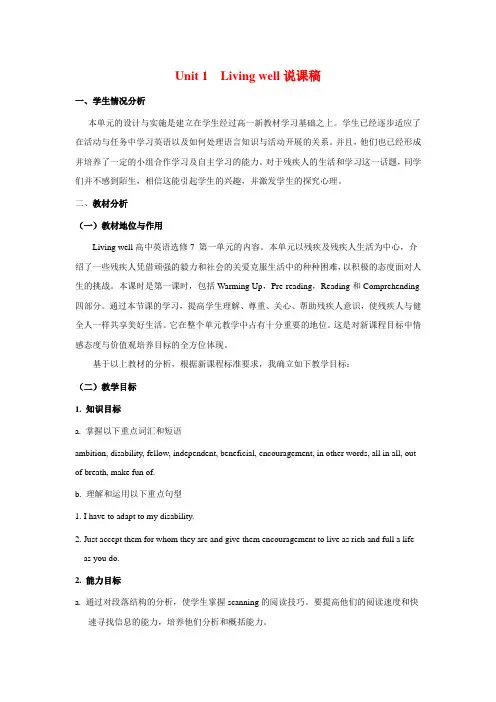
Unit 1 Living well说课稿一、学生情况分析本单元的设计与实施是建立在学生经过高一新教材学习基础之上。
学生已经逐步适应了在活动与任务中学习英语以及如何处理语言知识与活动开展的关系。
并且,他们也已经形成并培养了一定的小组合作学习及自主学习的能力。
对于残疾人的生活和学习这一话题,同学们并不感到陌生,相信这能引起学生的兴趣,并激发学生的探究心理。
二、教材分析(一)教材地位与作用Living well高中英语选修7 第一单元的内容。
本单元以残疾及残疾人生活为中心,介绍了一些残疾人凭借顽强的毅力和社会的关爱克服生活中的种种困难,以积极的态度面对人生的挑战。
本课时是第一课时,包括Warming Up,Pre-reading,Reading和Comprehending 四部分。
通过本节课的学习,提高学生理解、尊重、关心、帮助残疾人意识,使残疾人与健全人一样共享美好生活。
它在整个单元教学中占有十分重要的地位。
这是对新课程目标中情感态度与价值观培养目标的全方位体现。
基于以上教材的分析,根据新课程标准要求,我确立如下教学目标:(二)教学目标1. 知识目标a. 掌握以下重点词汇和短语ambition, disability, fellow, independent, beneficial, encouragement, in other words, all in all, out of breath, make fun of.b. 理解和运用以下重点句型1. I have to adapt to my disability.2. Just accept them for whom they are and give them encouragement to live as rich and full a life as you do.2. 能力目标a. 通过对段落结构的分析,使学生掌握scanning的阅读技巧。
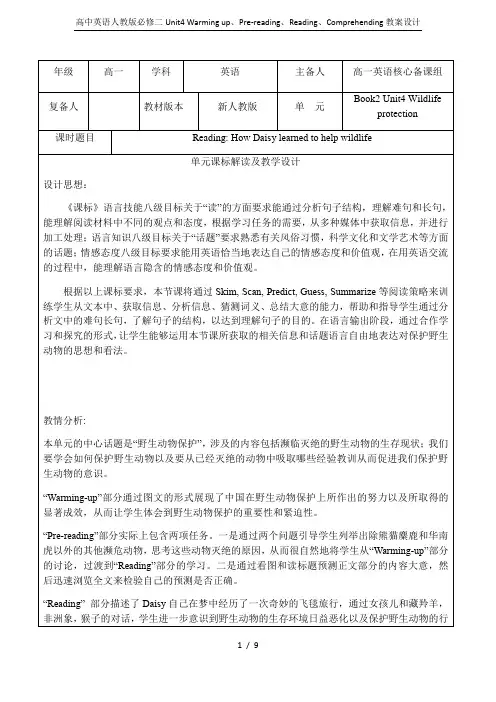

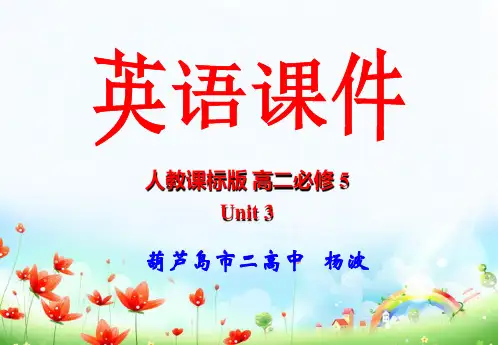
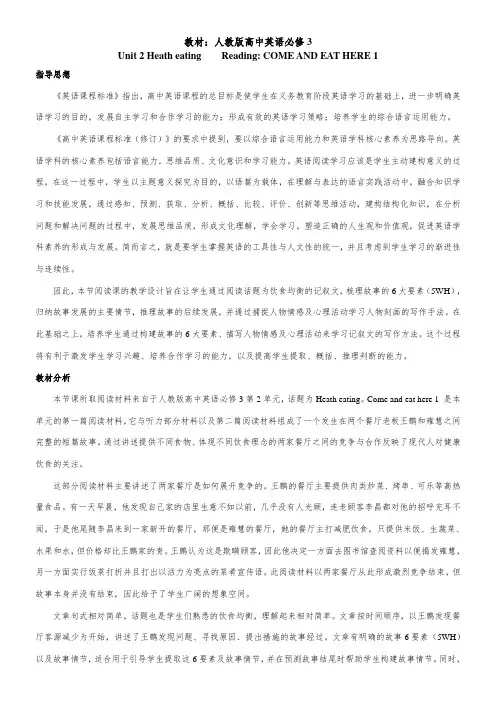
教材:人教版高中英语必修3Unit 2 Heath eating Reading: COME AND EAT HERE 1指导思想《英语课程标准》指出,高中英语课程的总目标是使学生在义务教育阶段英语学习的基础上,进一步明确英语学习的目的,发展自主学习和合作学习的能力;形成有效的英语学习策略;培养学生的综合语言运用能力。
《高中英语课程标准(修订)》的要求中提到,要以综合语言运用能力和英语学科核心素养为思路导向。
英语学科的核心素养包括语言能力,思维品质、文化意识和学习能力。
英语阅读学习应该是学生主动建构意义的过程,在这一过程中,学生以主题意义探究为目的,以语篇为载体,在理解与表达的语言实践活动中,融合知识学习和技能发展,通过感知、预测、获取、分析、概括、比较、评价、创新等思维活动,建构结构化知识,在分析问题和解决问题的过程中,发展思维品质,形成文化理解,学会学习,塑造正确的人生观和价值观,促进英语学科素养的形成与发展。
简而言之,就是要学生掌握英语的工具性与人文性的统一,并且考虑到学生学习的渐进性与连续性。
因此,本节阅读课的教学设计旨在让学生通过阅读话题为饮食均衡的记叙文,梳理故事的6大要素(5WH),归纳故事发展的主要情节,推理故事的后续发展,并通过捕捉人物情感及心理活动学习人物刻画的写作手法。
在此基础之上,培养学生通过构建故事的6大要素、描写人物情感及心理活动来学习记叙文的写作方法。
这个过程将有利于激发学生学习兴趣、培养合作学习的能力,以及提高学生提取、概括、推理判断的能力。
教材分析本节课所取阅读材料来自于人教版高中英语必修3第2单元,话题为Heath eating。
Come and eat here 1 是本单元的第一篇阅读材料,它与听力部分材料以及第二篇阅读材料组成了一个发生在两个餐厅老板王鹏和雍慧之间完整的短篇故事。
通过讲述提供不同食物、体现不同饮食理念的两家餐厅之间的竞争与合作反映了现代人对健康饮食的关注。
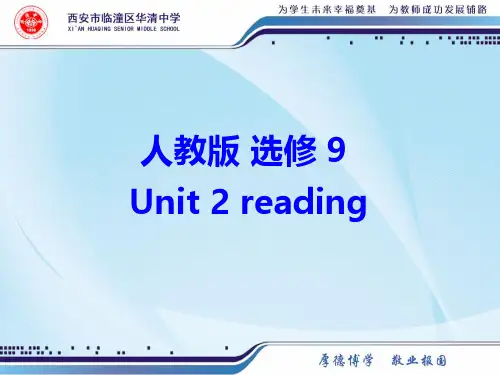
Rea dingTeaching goals1. Target languagea. Important words and expressionscalculator, notebook, common, calculate, analytical, technological, revolution, universal, mathematical, simple, simple-minded, artificial intelligence, anyway, totally, network, trulyb. Sentences1) My real father was Alan Turing, who in 1936 wrote a book to describe how computers could be made to work, and built a "universal machine" to solve any mathematical problem. P182) As the years have gone by, I have been made smaller and smaller. P183) I became small and thin but I got cleverer and cleverer, quicker and quicker. P184) And my memory became so large that I couldn't believe it! P182. Ability goalsEnable the students to grasp the progress of computers.3. Learning ability goalsEnable the students to state the progress in chronologyorder.Teaching important pointsTry to finish the exercises of Comprehending.Teaching difficult pointsEnable the students to learn how to grasp the structure of the text.Teaching methodsa. Listening method.b. Skimming method.c. Task-based method.Teaching aidsA recorder and a computer.Teaching procedures & waysStep I Revision1. Greetings.2. Ask students the spelling and meaning of some important words and phrases in the text.Step II Pre-readingT: Boys and girls, from the last lessons Speaking and Listening, we have learnt something about computers. Now, please look at the screen and discuss these questions with your partner. Then I'll ask some students to report your work. Are you clear?Ss: Yes, sir / madam.Show the slide.1. What do you know about computers?2. How have computers changed our lives?After a few minutes.T: Now, who'd like to answer the first question? Volunteer!S1: Let me try. I think that our computers developed from large machines. They developed quickly and they are very useful....T: Quite right. A computer contains many small parts. If you are interested in computers, you may go on studying them in your spare time. Next question!S2: / think that computers are very useful. They change our lives greatly. We use the computers widely in our study, in our work, even in our games. In the modern society, using the computers means grasping a tool of controlling the world. We may communicate with each other from a very long distance by them. In short, we can not live freely without them.Step III ReadingThis material is the most important part of this unit. So let the students read it carefully and require the students to understand every sentence and grasp all the language points.T: Boys and girls, do you want to know more about computers? Do you want to know the history of computers? Well, let's learn the Reading carefully. Are you clear? Then get the general idea of the Reading in your mind. Are you ready?Ss: Yes, sir / madam.Students read carefully.T: Who would like to give the general idea of the text to the class? Volunteer!S1: The text is mainly about the history and development of computers.S2: What's more, it is also about the relationship between computers and humans.T: Quite right. Let's go on understanding the text. Step IV ExplanationDuring this procedure, teacher will play the tape for students.The students will underline the difficult sentences. After listening to the tape, teacher will explain the text and ask the students to refer to Notes 1-9 on pages 79-80 and learn the words and phrases "thought, love, enough".T: We have learned the main idea of the text. Now let's read the text carefully and pay special attention to some details. This time we will deal with some difficult language points. Next I'll play the tape for you.After listening.T: Now let's deal with some language points. Turn to page 18. Let's look at the sentences.1.I know this sounds very simple, but at that time it was a technological revolution! P18 Here "this" refers to the thing that "I followed instructions from cards with holes. Now, we can see, it is a very easy, simple thing. But at that time, exactly in 1822, it was a very big, important thing or a technological revolution.2. My real father was Alan Turing, who in 1936 wrote a book to describe how computers could be made to work, and built a "universal machine" to solve any mathematical problem. P18T: Let's analyze the structure of this sentence. "who ... wrote ... to describe how... and built... problem" is an attributive clause. In the clause, "and" connects two verbs: wrote and built.Step V ComprehendingTask1T: Class, please go over the story and discuss with your partner who you think is the speaker in this story. Who would like to tell me? Volunteer!S1: / think in this story, the speaker is a computer.T: Quite right. Now write down three sentences from the story to support your idea. Who can?S2: / began only as a calculating machine in 1642 in France.S3: Then in 1822 I was built as an Analytical Machine by Charles Babbage.S4: Earlier I was not very big, but then I became huge!T: Very good, there are some more similar sentences in the text. You may find them out in your spare time.Task 2T: Now, please look at the timeline on page 19. Then fill in the blanks with information from theReading above.Students will be asked to tell the details to the class. Now, who would like to give your answer?S5: 7642: A calculating machine was used in France.S6: 1822: The Analytical Machine was made by Charles Babbage.S7: 7936: Alan Turing wrote a book to describe how computers could be made to work and built a "universal machine" to solve any mathematical problem.S8: 1960s: Computers got new transistors.S9: 1960s: The first family of computers connected to eachOther.S10: 1970s: Computers were brought into people's homes.Sll: Now: Computers have been used by billions of people to deal with information and communicate with each other around the world by the Internet. T: Your details are quite right. From the details we can see the timeline of computer history. We must remember it. Are you clear? Step VI Homework1. Recite the key sentences in the text.2. Prepare for Learning about Language.。